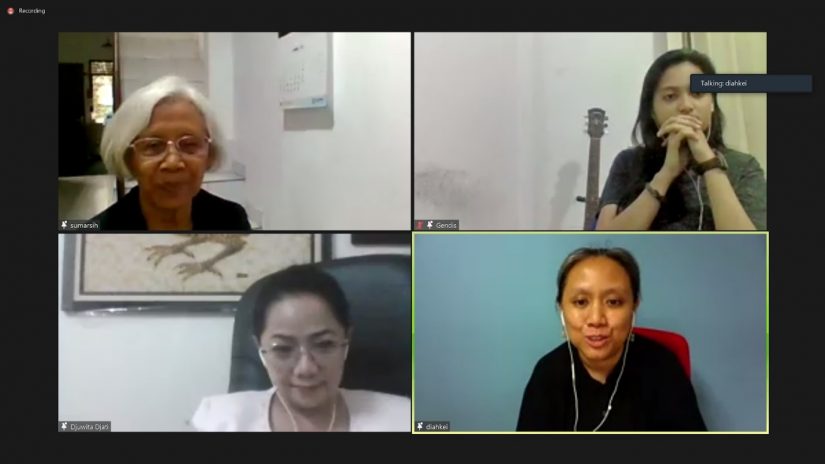
Yogyakarta, April 30th 2021━According to the data of Damai Pangkal Damai (DPD), there have been more than fourteen thousand nonviolent actions that have occurred in Indonesia since 1999. Based on this data, the DPD together with the Institute of International Studies (IIS) of FISIPOL UGM held a Webinar on Nonviolent Resistance in Indonesia entitled “Whoever leaves violence …” on the last Friday (30/4). The event featured representatives from several movements and organizations in Indonesia that rely on nonviolent resistance strategies. The speakers that presented in this event were Maria Catarina Sumarsih as the representative of Aksi Kamisan (Kamisan Action), Djuwita Djatikusumah from indigenous Sunda Wiwitan community, and Gendis Syari that represented Gejayan Memanggil. On this occasion, Dr. Diah Kusumaningrum as the lecturer of the Department of International Relations of FISIPOL UGM, presented as the moderator.
Starting the discussion, Sumarsih told the story about Aksi Kamisan which has been going for 677 weeks. The initiative of this action came after her son, Bernardinus Realino Norma, became one of the 1st Semanggi Tragedy victims in 1998. The families of the victims joined the Aksi Kamisan to demand substantive justice legally. According to Sumarsih, the Aksi Kamisan which was carried out in silence in front of the State Palace (Istana Negara) did not mean that they lost their rights, but showed themselves as citizens who demanded justice in an orderly manner. “The State Palace was chosen as a symbol of power. Thursday at four in the afternoon was chosen because that’s when the traffic was busy, people were leaving work. Each of us also carries a black umbrella,” Sumarsih explained.
The second speaker, Djuwita Djatikusumah told her story as a companion to the indigenous Sundanese Wiwitan community. In her session, Djuwita said that the civil rights of indigenous peoples and followers of belief have not been fulfilled, nor have they received legal protection umbrellas. One of the cases that occurred was the execution and seizure of the grave of the Sunda Wiwitan family in Cigugur, Kuningan, West Java. The tomb was rumored to be a place of worship and was then sealed and threatened to be closed. Djuwita said, “The masses came to reject the construction of the tomb. They demanded an IMB.”

Djuwita’s own strategy of nonviolent resistance was carried out through arts that she taught to the children. “I strengthen the children, lead them to situations that are strong, happy, and confident. They move through dance, batik, and other works of art to be performed,” she explained. One of the non-violent acts through these works of art was carried out at the Constitutional Court while conveying the injustice.
The last session was presented by Gendis Syari, one of the initiators of Gejayan Memanggil (Gejayan is Calling). According to Gendis, there are two intersections of issues that were brought into action, they are the alignments of state development and political issues after the 2019 General Election. “There was binary opposition between the supporters of the two presidential candidates at that time. Gejayan Memanggil was wishing to present a new civilian movement outside of the earlier polarity and to create a narrative against the issue of alignments with development,” Gendis said. She also talked about many accusations regarding Gejayan Memanggil, many people accused that this action was rode by someone.
Closing the webinar event, Diah Kusumaningrum as moderator stated the similarities between the three nonviolent movements that were present that afternoon. “The three of them balance the resistance with peace,” she concluded.
